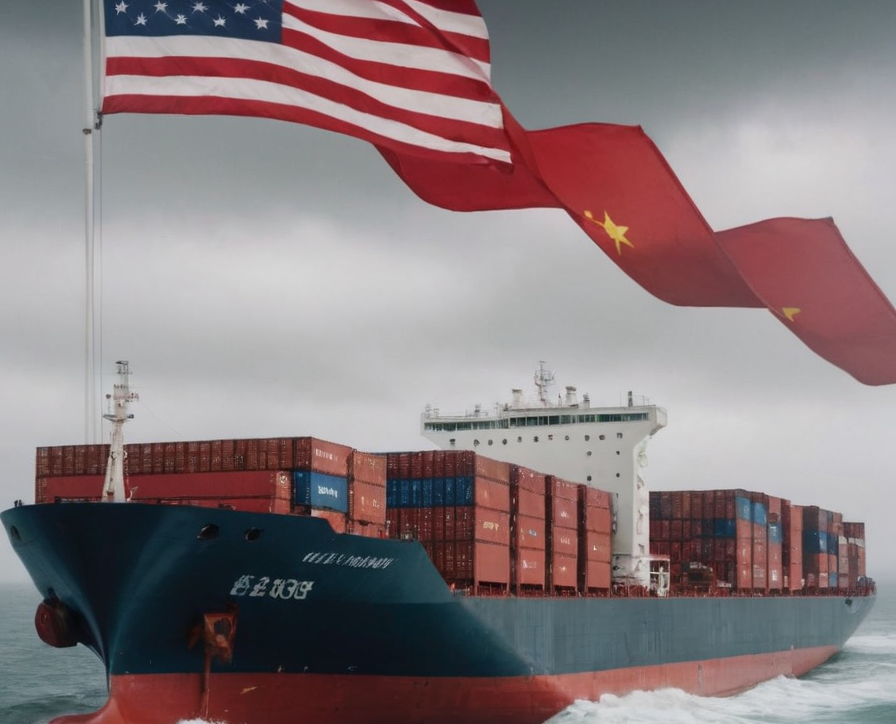Donald Trump tariff war- Impact on the tech industry

Introduction: Donald Trump Tariff war part 1
The tech industry has long been built on global supply chains, where components and innovations move freely across borders. However, during Donald Trump’s presidency in his first term, his aggressive trade policies—specifically targeting China—triggered a tariff war that deeply impacted the tech sector. From skyrocketing costs to supply chain disruptions, these tariffs forced companies to rethink their strategies. But how did this economic battle reshape the global tech industry, and what lasting effects does it continue to have? For clarity sake let us call this the Donald Trump Tariff war, and try to understand the impact this may have on the tech industry in particular.
The Origins of Donald Trump Tariff War:
Donald Trump tariff war, initiated during his first term, primarily aimed to reduce the U.S. trade deficit with China, curb intellectual property theft, and push for fairer trade agreements. Trump’s first term tariff war, basically did nothing to alter the status quo in the economic sense and was mostly seen as saber rattling. The tech industry, however, became an unintended casualty due to its heavy reliance on Chinese manufacturing. Key events include:
- 2018: Imposition of 25% tariffs on $50 billion worth of Chinese imports, affecting components like semiconductors, circuit boards, and lithium-ion batteries.
- 2019: Expanded tariffs on an additional $200 billion in Chinese goods, impacting smartphones, laptops, and networking equipment.
- Blacklisting Huawei, restricting the Chinese tech giant’s access to U.S. software and hardware, further escalating tensions.
How the Tariffs Disrupted Global Tech Supply Chains
The immediate consequence of the Donald Trump tariff war was a sharp increase in manufacturing costs for tech companies. Key disruptions included:
1. Rising Costs for Consumers and Businesses
- Higher tariffs meant increased costs for components like processors, screens, and microchips.
- Companies like Apple and Dell had to weigh absorbing costs or passing them on to consumers.
- Small and medium-sized tech firms struggled to keep prices competitive.
2. Semiconductor Industry Fallout
- The semiconductor industry was one of the hardest hit, as U.S. chipmakers depend on China both as a supplier and a major market.
- Companies like Qualcomm, Intel, and Nvidia faced revenue losses due to export restrictions.
- China accelerated efforts to develop self-sufficient semiconductor production, reducing reliance on U.S. technology.
3. Shift in Manufacturing Hubs
- Major tech firms diversified production away from China to avoid tariffs.
- Vietnam, India, and Mexico became alternative manufacturing hotspots.
- This shift led to logistical and quality control challenges, increasing operational costs.
Winners of Trump’s Tariff War (First Tenure 2017-2021)
- Vietnam & Other Southeast Asian Nations – As companies sought to avoid U.S.-China tariffs, Vietnam, Thailand, and Malaysia became major beneficiaries, attracting investments from companies relocating production. Vietnam, in particular, saw a surge in tech manufacturing, including factories for Samsung, Apple suppliers, and other electronics firms.
- U.S. Domestic Steel & Aluminum Industry – With tariffs on imported steel and aluminum, domestic producers initially benefited from reduced foreign competition and increased demand. Companies like U.S. Steel saw short-term price hikes that boosted profits and investments in domestic production.
- Mexico – As manufacturers moved operations from China to avoid tariffs, Mexico became a key alternative for U.S.-based firms. The USMCA (which replaced NAFTA) further encouraged manufacturing growth, especially in the auto and electronics industries.
Losers of Trump’s Tariff War (First Tenure 2017-2021)
- U.S. Consumers – With tariffs raising the cost of imported goods, everyday consumers faced higher prices on everything from electronics to household appliances. Inflationary effects were particularly felt in industries reliant on Chinese manufacturing, making essential tech products like smartphones and laptops more expensive.
2. U.S. Farmers & Agricultural Exporters – China retaliated with tariffs on American soybeans, pork, and other agricultural goods, significantly impacting farmers in the Midwest. Many lost access to key markets, leading to billions in lost revenue and forcing the U.S. government to issue bailout payments to offset damages.
3.U.S. Tech Companies – Firms like Apple, Intel, and Qualcomm faced higher costs due to tariffs on Chinese-made components. The semiconductor industry, heavily dependent on Chinese markets, suffered from retaliatory tariffs, restricting access to a key revenue source.
Donald Trump Tariff war-Part 2, 2025:
Donald Trump’s tariff war, initially launched to reduce trade deficits and bring manufacturing jobs back to the U.S., continues to shape global trade in 2025. The logic behind the tariffs was that by making imports more expensive, domestic production would become more competitive, boosting American industry. However, this approach overlooked the complexity of modern supply chains, where even U.S.-based companies rely on foreign components, particularly from China. As a result, higher costs were often passed on to consumers, while retaliatory tariffs hurt American exporters, especially in sectors like technology, agriculture, and automotive manufacturing.
In 2025, President Donald Trump announced a series of tariffs aimed at reducing trade deficits and encouraging domestic manufacturing. The key tariffs imposed include:
- 20% Tariff on All Chinese Goods: Effective February 4, 2025, this tariff was increased from an initial 10% to 20% on March 4, 2025.
- 25% Tariff on All Mexican Goods: Announced on February 1, 2025, and partially implemented on March 4, 2025. Tariffs on USMCA-compliant goods were delayed until April 2, 2025.
- 10% Tariff on Canadian Oil and Gas: Scheduled to take effect on March 4, 2025, but delayed until April 2, 2025.
- 25% Tariff on Automobiles: Announced on March 26, 2025, to be implemented on April 3, 2025, under Section 232 following a 2019 investigation.
- 25% Tariff on Auto Parts: Announced alongside the automobile tariffs, with implementation expected by May 3, 2025. USMCA-compliant auto parts will remain tariff-free until a process is established to apply tariffs to their non-U.S. content.
- Reciprocal Tariffs: Set to begin on April 2, 2025, these tariffs aim to match the duties that other countries impose on U.S. products.
These measures represent a significant shift in U.S. trade policy, with potential implications for global trade dynamics and various industries.
Over the long term, the global economy is adapting by planning the formation of new alliances, such as the European Union strengthening intra-regional trade and China deepening ties with Japan and South Korea. This shift has left the U.S seeming increasingly isolated in key industries, particularly semiconductors and clean energy technologies. While the tariffs aimed to strengthen U.S. manufacturing, they instead accelerated global supply chain diversification, making it harder for the U.S. to reclaim its dominant position in key tech and industrial sectors.
Long-Term Effects on the Global Tech Industry
The tariff war had far-reaching consequences beyond immediate financial losses:
- Acceleration of Tech Nationalism: Countries are investing in self-reliant tech ecosystems, reducing dependency on foreign suppliers.
- Redefining Supply Chains: Tech companies now prioritize risk mitigation over cost efficiency, leading to decentralized production.
- Innovation in Trade Partnerships: New alliances, such as the U.S.-India semiconductor partnership, emerged to counterbalance Chinese dominance.
Donald Trump Tariff War: What the future holds for the Tech industry
The future of the tech industry is shifting toward a multipolar trade landscape, where the U.S. is increasingly isolated from major manufacturing and supply chain agreements. With Trump’s ambition of bringing manufacturing back to the U.S. proving impractical due to high costs and a lack of infrastructure, companies will continue diversifying production across Asia, Europe, and Latin America.
The European Union’s push for greater self-reliance in tech—excluding the U.S. from key trade deals—will likely fuel the rise of European semiconductor, AI, and telecom firms, reducing reliance on American tech giants. Meanwhile, China, Japan, and South Korea working together signals stronger regional cooperation, making East Asia an even more dominant tech powerhouse in semiconductor production, consumer electronics, and 5G infrastructure. As a result, U.S. tech firms may face increased barriers to global markets, forcing them to either adapt through strategic partnerships or risk losing influence in the rapidly evolving global tech economy.
If you are enjoying our take on the Donald Trump tariff war, and the impact it is likely to have on the tech industry, please do read up our article on the latest trends and innovations in the field of AI.
Conclusion
Trump’s tariff war, launched in his first term and reignited in his second, has left a lasting imprint on the global tech industry. Initially aimed at reducing reliance on China and reviving U.S. manufacturing, the strategy instead led to rising production costs, disrupted supply chains, and an accelerated shift of manufacturing to third-party countries.
While the first round of tariffs forced companies to rethink supply chain resilience, the second wave in his 2025 term has deepened global fragmentation, with regions like the EU and East Asia forming stronger trade alliances that exclude the U.S. As a result, American tech firms now face increased trade barriers and a more competitive global market, where dominance in sectors like semiconductors, AI, and consumer electronics is no longer guaranteed. In the long run, unless the U.S. adapts with new industrial policies and cooperative trade agreements, it risks falling behind in the race for technological innovation and global market influence.



